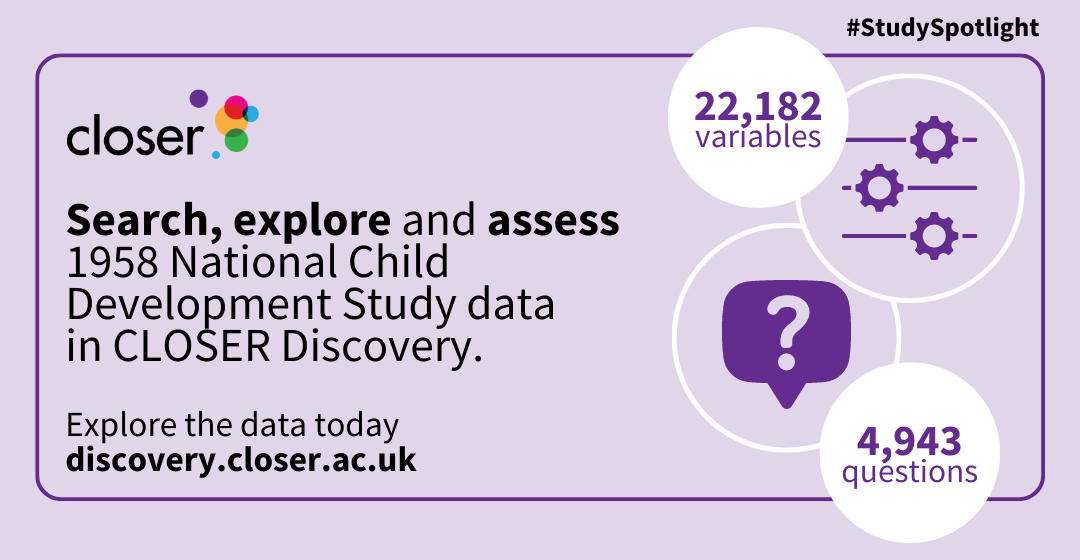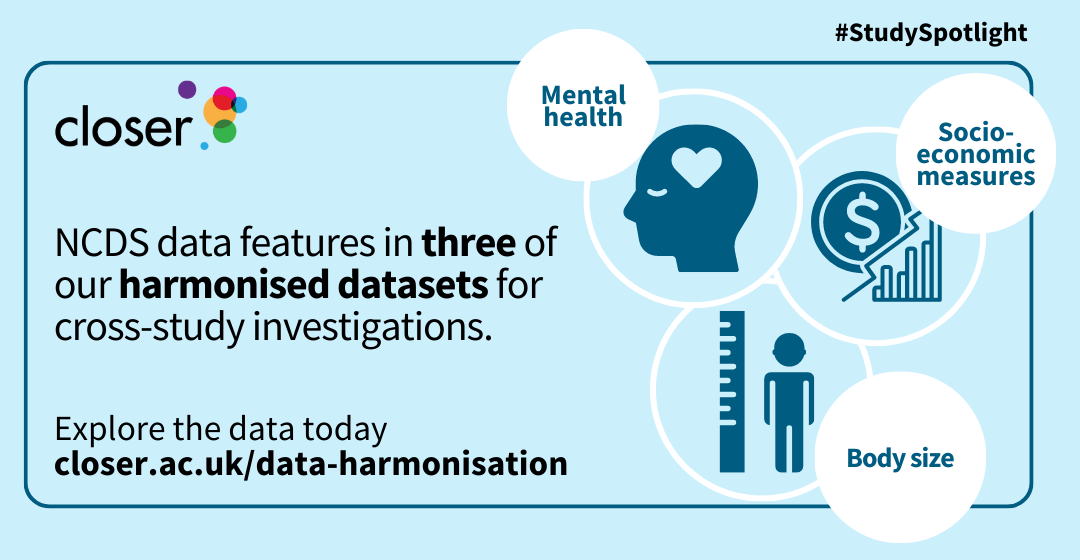 As we round off our focus on the British birth cohorts managed by the UCL Centre for Longitudinal Studies, we showcase the oldest of the three studies – the 1958 National Child Development Study.
As we round off our focus on the British birth cohorts managed by the UCL Centre for Longitudinal Studies, we showcase the oldest of the three studies – the 1958 National Child Development Study.
About the study
The 1958 National Child Development Study (NCDS) follows the lives of 17,415 people born in England, Scotland and Wales in a single week in 1958. The initial study was established to understand the reasons behind the stillbirth rates in Britain and its findings immediately helped improve maternity services and the reduction of perinatal deaths.
Having recognised the research potential of the study, the National Children’s Bureau was commissioned to extend it, retracing the original participants and monitoring their educational, physical, and social development at age 7.
Since then, there have been 10 follow-up surveys including the current survey, at age 62, which was paused due to the pandemic but is in the field now.
Recent research using the study data has explored:
- Intergenerational home ownership
- The association between internalising symptoms in childhood and pragmatic skills in later life
- The association between depression and physical function in midlife
Find out more about NCDS from Dr Morag Henderson and Dr Vanessa Moulton in our introduction to the CLS longitudinal cohort studies from a biomedical perspective video.
Discover the data
 With six decades of follow-up surveys (and still ongoing!), the study has collected a wealth of information on a range of topics, including physical health, health behaviours, education, and COVID-19 and mental health.
With six decades of follow-up surveys (and still ongoing!), the study has collected a wealth of information on a range of topics, including physical health, health behaviours, education, and COVID-19 and mental health.
You can explore all this data using our innovative research tool – CLOSER Discovery enables you to search, explore and assess NCDS (and many other birth cohorts and longitudinal population studies) in an unprecedented level of detail. A filtered search, looking solely at NCDS, pulls up detailed information about 4,943 questions and 22,182 variables across 36 data sets from the study.
Response to the COVID-19 pandemic
NCDS is one of five national longitudinal population studies that worked together during the early stages of the pandemic to conduct bespoke surveys to help understand the impact of the pandemic on their participants. NCDS also joined the Longitudinal Health and Wellbeing National Core Study which brought together 12 longitudinal population studies to help understand the impacts of the COVID-19 pandemic.
Interested in finding out more? You can use our COVID-19 Research Tracker to access all the briefing notes, reports, academic publications and articles that use NCDS COVID-19 data.
Opportunities for cross-study research
Cross-study analysis can be utilised to gain deeper insights into group disparities, the influence of contextual factors, and the effects of societal shifts on individual outcomes.
To facilitate cross-study comparisons, we have developed three comprehensive data guides to help researchers explore cognitive abilities, dietary patterns, and physical activity levels across multiple longitudinal population studies. Detailed information on the measures gathered in NCDS is included in all three guides.
 NCDS data also features in our harmonised datasets, which aim to support researchers to conduct cross-study projects. These include harmonised measures of the following themes, collected across five longitudinal population studies:
NCDS data also features in our harmonised datasets, which aim to support researchers to conduct cross-study projects. These include harmonised measures of the following themes, collected across five longitudinal population studies:
Research using the harmonised dataset of mental health found poorer relationship with parents in childhood were associated with lower well-being during adulthood across three generations born a decade apart.
If you are interested in specific case studies that used our harmonised data sets, such as Britain’s mobility problem, the scarring effects of childhood bullying , and the rise of the obesity epidemic, you can find all of them on our Learning Hub!
Scratching the surface
Of course, this spotlight is just a whistle-stop tour of NCDS and how you can use the study in your research. As the study continues, and with the Age 62 data deposit on the horizon, we look forward to seeing what new insights the study can tell us about the baby boomer generation.
You can keep up to date with all the latest developments on NCDS and the longitudinal research community via our monthly newsletter, Longitudinal News.
Further information
This blog is part of our ‘Study Spotlight’ series. This series showcases the CLOSER partner studies, demonstrating how to make the most of these valuable assets through CLOSER’s research resources. Every month, we turn the spotlight on a new theme, producing a series of blogs that delve into the backgrounds of studies that share similar characteristics, such as their study sample, design, or topics of research interest.
‘Study Spotlight’ helps you gain a deeper understanding of the studies in our partnership and how you can better utilise these on your research journey.
Keep an eye out for next month’s Study Spotlights which will showcase Understanding Society: the UK Household Longitudinal Study and the ONS Longitudinal Study.
Previous Study Spotlight blogs:
- ALSPAC and the millennial generation (April 2023)
- Next Steps and the millennial generation (April 2023)
- ELSA and the ageing population (May 2023)
- Hertfordshire Cohort Study and the ageing population (May 2023)
- MRC NSHD and the ageing population(May 2023)
- MCS and the British birth cohorts (June 2023)
- BCS70 and the British birth cohorts (June 2023)
On Twitter? Follow #StudySpotlight to keep up to date with the series throughout the year.
Related links:
- Follow @CLScohorts on Twitter
- CLOSER NCDS Study profile
- NCDS study page on the CLS website
- CLS Video: Introduction to the 1958 National Child Development Study
- CLS training and support
- Image sourced from the Centre for Ageing Better
Suggested citation:
Li, M. (2023). ‘Study Spotlight: NCDS and the British birth cohorts’. CLOSER. 27 June 2023. Available at: https://closer.ac.uk/news-opinion/blog/study-spotlight-ncds-and-the-british-birth-cohorts/
